The Oklahoma redbud tree, scientifically named Cercis canadensis var. texensis ‘Oklahoma,’ stands out as an ideal addition to almost any residential landscape. As spring dawns, this tree showcases an impressive display of radiant purple flowers, reminiscent of a bouquet in full bloom.
Following this floral spectacle, its leaves unfurl, initially exhibiting a soft pinkish tint which gracefully subsides as the season advances. A defining characteristic of the Oklahoma redbud is its uniquely glossy leaves, setting it apart from other redbud varieties.
Beyond its visual appeal, this tree is notably resilient, withstanding drought and thriving in a variety of soil conditions. Whether planted in part shade or basking in full sun, the Oklahoma redbud remains a stunningly shaped tree, especially suitable for smaller yards and warmer, arid climates. Its vivid rosy-purple blossoms are a testament to the vibrant burst of spring color it promises each year.
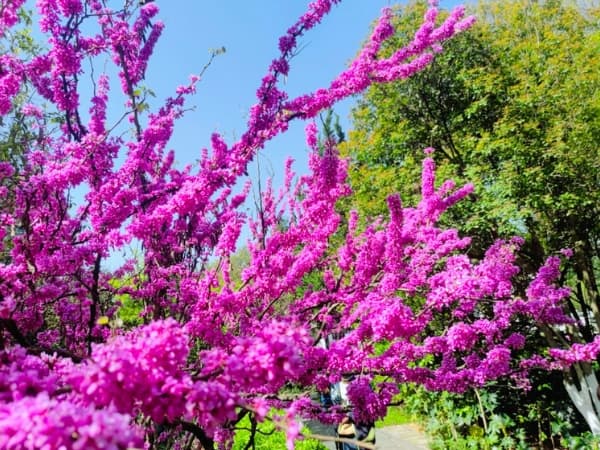
II. Appearance
The Oklahoma redbud tree boasts a modest stature in the realm of landscape trees, typically peaking up to 18 feet in height. Its rounded silhouette means that its breadth often mirrors its height, rendering it an attractive choice for homeowners wary of overshadowing neighboring plants. While many redbud trees share similarities, the Oklahoma redbud stands apart in a couple of notable ways.
For one, it’s particularly adapted to warmer climates. While some redbuds thrive as far north as zone 4, the Oklahoma redbud is hardy down to zone 6. Moreover, its leaves are a standout with a glossy finish, sometimes emerging with a delicate pink hue, setting it apart from its redbud counterparts.
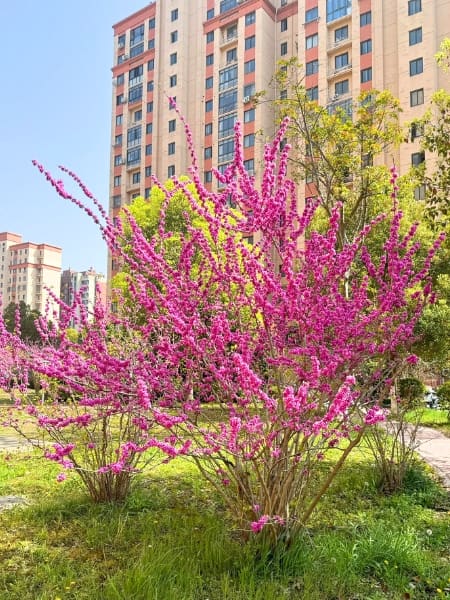
III. Growing and Care Conditions
Planting
The Oklahoma redbud tree is often seen as a delightful prelude to spring, its presence warming landscapes after a long winter. With mesmerizing purple-pink blooms covering even its mature trunks, this tree’s resilience is awe-inspiring. It thrives under varying light conditions, from full sun to partial shade, and is indifferent to soil type, be it acidic, alkaline, clay, sand, or loam.
When setting down its roots, ensure the hole accommodates the tree’s root ball and allows room for growth. Backfill with water and seal the deal with a protective layer of organic mulch. Still, choose a spot that isn’t prone to stagnant water or flooding.
Light
Find a location that offers 4-6 hours of sunlight daily for optimal growth.
Watering
The first year of the Oklahoma redbud tree is crucial in terms of watering. Depending on local conditions like rainfall and temperature, ensure the soil remains consistently moist, but not waterlogged. Evening watering is recommended to maximize moisture absorption.
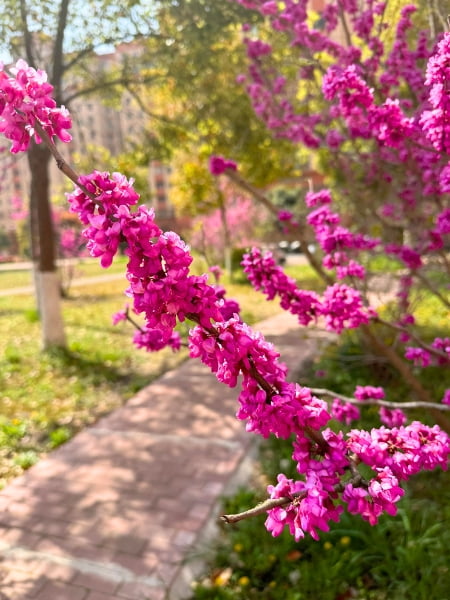
Fertilizer
As spring commences, nourish the soil with either compost or a balanced granular fertilizer like 5-10-5, following the prescribed guidelines. A maintained layer of organic mulch usually meets the tree’s nutritional demands.
Temperature
The Oklahoma redbud appreciates moderate temperatures, especially during its planting in spring and fall. It’s wise to avoid extreme temperatures for the best results.
Pruning
Young Oklahoma redbud trees benefit greatly from early pruning, establishing sturdy branch-to-trunk connections. Aim for U-shaped branch junctions, equipped to bear the weight of lush foliage and blossoms. The ideal pruning window is post-flowering in spring. While they often develop a naturally pleasing shape, periodic pruning promotes air circulation and disease prevention. Always use sanitized tools to mitigate disease transmission.
Pests and Diseases
While relatively resilient, the Oklahoma redbud is occasionally plagued by the fungus Botryosphaeria, leading to cankers and dieback. Insect challenges include caterpillars, weevils, scale insects, and treehoppers.
Pollination
Blessed with self-pollinating capabilities, the Oklahoma redbud bursts into bountiful blossoms each spring, attracting a plethora of pollinators like bees. This ensures a continuous cycle of reproduction and growth.
IV. Maintenance
The Oklahoma redbud tree, while generally low-maintenance, may occasionally benefit from some care. Pruning is not a regular necessity for this tree, but if branches appear dead, overlapping, or diseased, it’s advisable to prune right after the bloom season to retain the tree’s vibrant flower display in the subsequent year. Winter pruning can jeopardize the bloom.
For a thriving Oklahoma redbud, attention to its overall well-being is paramount. The primary elements of its care include correct positioning, adequate hydration, and suitable fertilization. An essential tip for ensuring its health is to keep the tree’s base free from mechanical injuries, such as those caused by lawn equipment.
Mulch proves useful in this regard, as it not only conserves moisture but also minimizes weed growth, reducing the need for machinery close to the tree. Protecting your tree from such damages is crucial, as Borer insects often exploit these vulnerabilities. For pests like Scale, a comprehensive coating of horticultural oil can be an effective solution.
One point to note is the Oklahoma redbud’s relative sensitivity to cold when compared to its counterparts like the eastern redbud. Its endurance is limited to areas not colder than zone 6. Furthermore, the Oklahoma redbud establishes a profound root system over time, making mature trees challenging to relocate. However, its compact nature ensures it remains a versatile choice for diverse landscapes.

V. Uses
The Oklahoma redbud tree stands out as an adaptable and attractive addition to various parts of a landscape. With its striking spring blooms, it’s no wonder the redbud tree is a favorite for many garden enthusiasts.
Positioning the redbud tree in a natural nook beside your home can transform the space, bathing it in a cascade of vibrant blossoms come spring. Alternatively, placing one or even a couple in prominent areas of your front or backyard can elevate the overall appearance of your space.
Its natural charm is accentuated when highlighted with uplighting, giving it an ethereal glow after sunset. For those seeking diversity in color, other variants like the Eastern, Royal White, or Forest Pansy trees can be considered.
The Oklahoma redbud’s hues harmoniously blend with a wide palette in the garden. For instance, pairing it with kaleidoscope abelia can create a stunning contrast of yellow and gold against the tree’s blossoms. Junipers, with their shades of blue and green, also complement the tree’s radiant purple-pink flowers.
Whether you choose to anchor it in a garden bed, beside your home, or in a group as a backdrop in your yard, the Oklahoma redbud remains a captivating sight.
If illuminated with uplights, its beauty can be appreciated even in the dark. Wherever it’s planted, ensure it’s visible from your common relaxation spots – be it a window, patio, or deck – so you can relish its blooming splendor year after year.
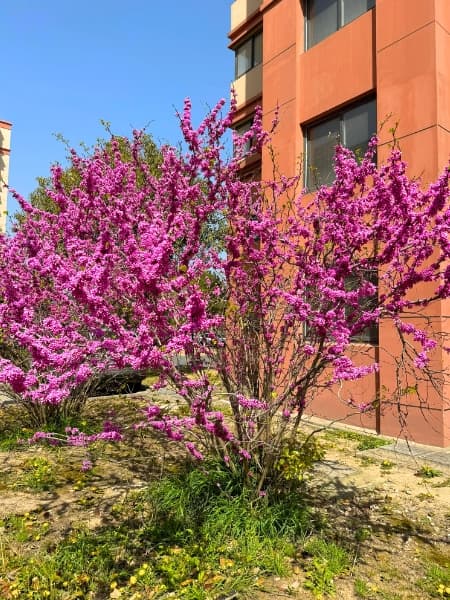
VI. Why should you buy this plant
The Oklahoma Redbud stands as a herald of spring, being among the first to showcase its vibrant purple-red blossoms. These enchanting clusters of flowers break through the bleakness of late winter, promising the warmth and colors of the upcoming season. Following this spectacle, rich dark green leaves unfurl, offering a lush canvas, and setting the stage for the rest of your garden.
This tree’s charm doesn’t just reside in its beauty; its compactness makes it a versatile choice for gardens of all sizes. Whether you have expansive grounds or a cozy backyard, the Oklahoma Redbud, which matures to a modest height of 12-18 feet, finds its place effortlessly, making it equally suitable as an accent or a standalone ornamental piece.
Yet, for all its delicacy in appearance, this redbud is robust. Its deep roots not only anchor it firmly, resisting damage from storms, ice, and wind, but also contribute to its resilience in varied conditions. Occasional droughts, rain showers, or gusty winds – this tree endures them all. Its hardiness, combined with its capacity to attract birds and butterflies, further elevates its value in a garden.
Beyond its spring bloom, the Oklahoma Redbud continues to mesmerize with changing hues – the soft pink of early summer and the myriad tones of autumn leaves. Its deep root system means it won’t outgrow or dominate a space, yet its presence is commanding, ensuring it remains a focal point.
A tree’s longevity can often be a concern, but with adequate care, the Oklahoma Redbud can grace your garden for several decades. Its lifespan, which can stretch to half a century or even longer, guarantees that you’ll savor its annual bloom, relishing the transformation it brings to your space. The key lies in nurturing it, ensuring it remains free of pests and diseases, allowing you to cherish its vibrant presence year after year.
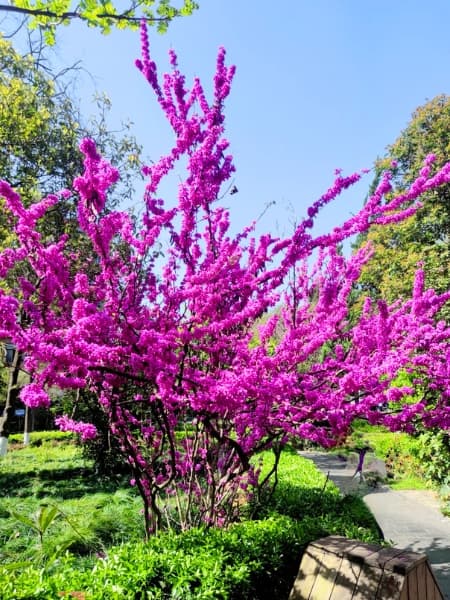
FAQs
When does the Oklahoma Redbud typically bloom?
The Oklahoma Redbud is among the first trees to bloom in the early spring, showcasing vibrant purple-red blossoms even in the late winter.
How big does the Oklahoma Redbud grow, and where can it fit in my garden?
The Oklahoma Redbud matures to a height of 12-18 feet, forming a compact and dense shape. Its size and form make it suitable for both small yards and larger landscapes, whether as an accent or a standalone ornamental piece.
Is the Oklahoma Redbud a durable tree?
Yes, the Oklahoma Redbud is robust, with a deep root system that makes it resistant to challenges like storms, ice, wind, and occasional droughts. It’s also known to attract birds and butterflies, enhancing its ecological value.
How long can I expect my Oklahoma Redbud tree to last in my garden?
With proper care, free from pests and diseases, the Oklahoma Redbud can thrive in a garden for several decades, often reaching or exceeding a lifespan of half a century.
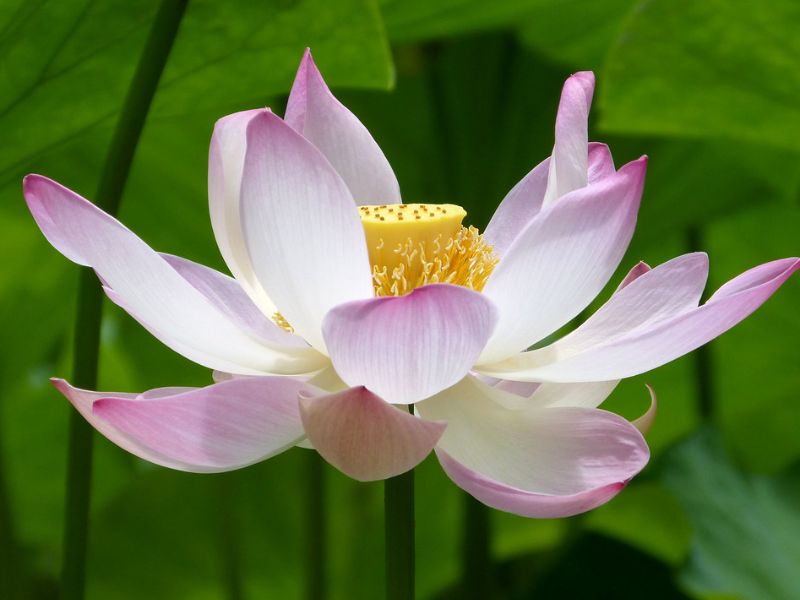
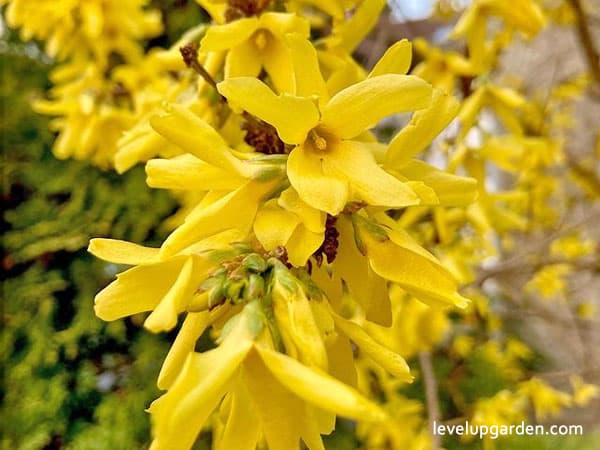






Leave a Reply